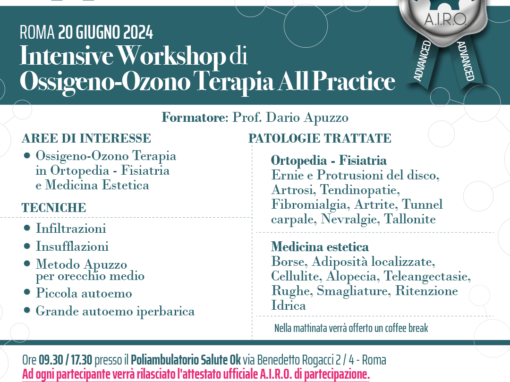A.I.R.O. è impegnata nell’attività di ricerca allo scopo di sfruttare le potenzialità dell’Ossigeno-Ozono Terapia nei numerosi campi di applicazione.
SPINE
1 June 2009 – Volume 34 – Issue 13 – pp 1337-1344
Intramuscular oxygen-ozone therapy in the treatment of acute back pain with lumbar disc herniation: a multicenter, randomized, double-blind, clinical trial of active and simulated lumbar paravertebral injection.
Dario Apuzzo, Paoloni M, Di Sante L, Cacchio A, , Marotta S, Razzano M, Franzini M, Santilli V.
Physical Medicine and Rehabilitation Unit, Azienda Policlinico Umberto I, Rome, Italy.
STUDY DESIGN:
Multicenter randomized, double-blind, simulated therapy-controlled trial in a cohort of patients with acute low back pain (LBP) due to lumbar disc herniation (LDH).
OBJECTIVE:
To assess the benefit of intramuscular-paravertebral injections of an oxygen-ozone (O2O3) mixture. SUMMARY OF BACKGROUND DATA: Recent findings have shown that O2O3 therapy can be used to treat LDH that fails to respond to conservative management. However, these findings are based on intradiscal/intraforaminal O2O3 injection, whereas intramuscular-paravertebral injection is the technique used most in clinical practice in Italy and other Western countries.
METHODS:
Sixty patients suffering from acute LBP caused by LDH was randomized to an intramuscular O2O3 or control group. Patients were observed up to assess pain intensity, LBP-related disability, and drug intake (15 [V2] and 30 [V3] days after treatment started, and 2 weeks [V4], and 3 [V5] and 6 [V6] months after treatment ended).
RESULTS:
A significant difference between the 2 groups in the percentage of cases who had become pain-free (61% vs. 33%, P < 0.05) was observed at V6. Patients who received O2O3 had a lower mean pain score than patients who received simulated therapy throughout the observation period. A significant improvement was observed in LBP-related disability in the study group patients when compared with the control group patients. Active O2O3 therapy was followed by a significantly lower number of days on nonsteroidal anti-inflammatory drugs at V2 and V3 and by a lower number of days at V4. No adverse events were reported.
CONCLUSION:
Treatment of LBP and sciatica is a major concern. Although the natural history of acute LBP is often self-limiting, conservative therapies are not always effective; in such cases, O2O3 intramuscular lumbar paravertebral injections, which are minimally invasive, seem to safely and effectively relieve pain, as well as reduce both disability and the intake of analgesic drugs.
Fonte: http://www.ncbi.nlm.nih.gov



